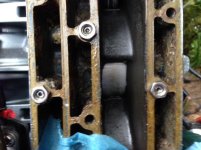Back in April 1998 I had a severe overheat event, #1 Combustion Chamber had a pinhole corrosion leak into waterjacket and I had to install a New Cylinder Head.
I wrote in the Logbook at that time, that "All bolts torqued with OMC Gasket Sealer Compound". I am positive I used no compound of any kind on the Block, Cylinder Head & Cover or factory (Yamaha 90TR) "self-sealing" gaskets. Just the bolts.
Fast forward 17 years and 200 motor hours and overheat buzzer is back. Lack of frequent use contributing factor no doubt and it's salt water, stored on davits and flushed after use.
After all the usual "overheat" trouble shooting, pulled head and head cover and each and every bolt came out like they were installed yesterday. They were coated with a Maple Syrup colored compound that was still soft and pliable. Head (and Cover) had no corrosion seen this time, but found partial blockage behind head where water exits. (overheat warning only occurred after 'on-plane' speed for five to twenty minutes).
This blockage material that I had mentioned on the 'Overheat Thread' a few days ago has not been dissolved by white vinegar (in a cup) immersion since that post.
Now for the Exhaust Cover removal attempt. I had removed it seventeen years ago to look at that #1 piston and rings and would have reinstalled it using the same OMC Gasket Sealer Compound to seal those bolts. Using this sealer would have been on the advice (at least for head bolts) of my very knowledgeable Marine Maintenance Expert at the time (Tad's Marine). This was prior to the existence of these knowledge sharing forums.
There are eighteen 8 mm bolts exactly the same as the head bolts made from a magnetic stainless alloy, no rust seen on either, just an inch shorter.
Completely unlike the ease of removing those head bolts, these were super stuck and the sealer was not soft and pliable any more. Seven out of the first thirteen snapped off deep inside, just past thread top. Block photo below shows four of those seven are along side exhaust passage but three are perimeter.
So it looks like OMC Gasket Sealer Compound is excellent Head Bolt protection but not at all suitable for exhaust cover.
The lowermost five bolts would be impossible to drill out without removing Power Head, so I used a 'sawz-all' hacksaw and cut their heads off to have the most shank to work with. Should'a sawed six as one just above cowling edge is too low for drill chuck, so I'll be removing Power Head anyway....
Photos two and three show inner exhaust cover plate, combustion side and water jacket side, four is water jacket side of outer cover. I have done no cleanup of these area's at all and it is obvious now that all would have been well if I'd never removed exhaust cover.
Photo five shows where I've die-cut threads into standing bolt stub and attempted to remove with two nuts (like you would a stud). Used all the heat available from 'MAP' Torch supplemented with an 1100 degree Heat gun and have gotten the stub to rotate less than five degrees in/out with more pressure than two (or three) nuts could apply. Wish I could weld, but that was my poorest skill in Shop Class. Photo six was just before OH buzzer started happening.
Cobalt Drill Bit (7/64th") goes all the way through center of bolts so I can inject Kroil, PB, ATF etc. but looks like I will need 17/64ths to run the 8mm/.125 Tap if I can find where threads start.
Tad retired and Tad's is now "THE BOAT HOUSE" (six locations from Chicago to Naples). They Service (and sell a lot of boats with) Yamaha, but are limited to Evinrude for Re-Power. They also tell me that it's not worthwhile to send block to Machine Shop for re-bore (or bolt extraction) and they just order "rebuilt", but then they're not who wants it to last a long time....
I am very tempted by this new 'Two-Stroke' Technology and low-speed Fuel Efficiency, but wish they made less noise. I read the past six months of this Evinrude Forum and found not one complaint mentioned about these latest Evinrude's, not the same over at Honda. I got soured on Automobile Engine's for raw cooled Salt Marine use with my Chevrolet engine'd Mercruiser long ago.
Wish me luck, Art
edit:- photos 2 & 3 are reverse of description and name
Art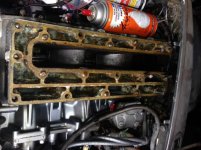
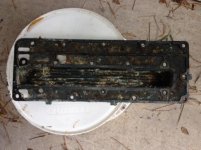
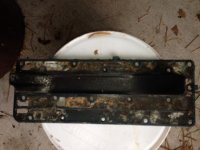
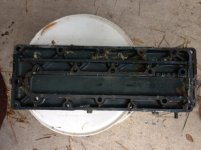
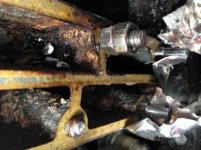
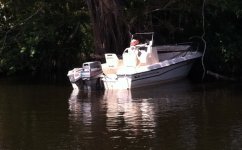
I wrote in the Logbook at that time, that "All bolts torqued with OMC Gasket Sealer Compound". I am positive I used no compound of any kind on the Block, Cylinder Head & Cover or factory (Yamaha 90TR) "self-sealing" gaskets. Just the bolts.
Fast forward 17 years and 200 motor hours and overheat buzzer is back. Lack of frequent use contributing factor no doubt and it's salt water, stored on davits and flushed after use.
After all the usual "overheat" trouble shooting, pulled head and head cover and each and every bolt came out like they were installed yesterday. They were coated with a Maple Syrup colored compound that was still soft and pliable. Head (and Cover) had no corrosion seen this time, but found partial blockage behind head where water exits. (overheat warning only occurred after 'on-plane' speed for five to twenty minutes).
This blockage material that I had mentioned on the 'Overheat Thread' a few days ago has not been dissolved by white vinegar (in a cup) immersion since that post.
Now for the Exhaust Cover removal attempt. I had removed it seventeen years ago to look at that #1 piston and rings and would have reinstalled it using the same OMC Gasket Sealer Compound to seal those bolts. Using this sealer would have been on the advice (at least for head bolts) of my very knowledgeable Marine Maintenance Expert at the time (Tad's Marine). This was prior to the existence of these knowledge sharing forums.
There are eighteen 8 mm bolts exactly the same as the head bolts made from a magnetic stainless alloy, no rust seen on either, just an inch shorter.
Completely unlike the ease of removing those head bolts, these were super stuck and the sealer was not soft and pliable any more. Seven out of the first thirteen snapped off deep inside, just past thread top. Block photo below shows four of those seven are along side exhaust passage but three are perimeter.
So it looks like OMC Gasket Sealer Compound is excellent Head Bolt protection but not at all suitable for exhaust cover.
The lowermost five bolts would be impossible to drill out without removing Power Head, so I used a 'sawz-all' hacksaw and cut their heads off to have the most shank to work with. Should'a sawed six as one just above cowling edge is too low for drill chuck, so I'll be removing Power Head anyway....
Photos two and three show inner exhaust cover plate, combustion side and water jacket side, four is water jacket side of outer cover. I have done no cleanup of these area's at all and it is obvious now that all would have been well if I'd never removed exhaust cover.
Photo five shows where I've die-cut threads into standing bolt stub and attempted to remove with two nuts (like you would a stud). Used all the heat available from 'MAP' Torch supplemented with an 1100 degree Heat gun and have gotten the stub to rotate less than five degrees in/out with more pressure than two (or three) nuts could apply. Wish I could weld, but that was my poorest skill in Shop Class. Photo six was just before OH buzzer started happening.
Cobalt Drill Bit (7/64th") goes all the way through center of bolts so I can inject Kroil, PB, ATF etc. but looks like I will need 17/64ths to run the 8mm/.125 Tap if I can find where threads start.
Tad retired and Tad's is now "THE BOAT HOUSE" (six locations from Chicago to Naples). They Service (and sell a lot of boats with) Yamaha, but are limited to Evinrude for Re-Power. They also tell me that it's not worthwhile to send block to Machine Shop for re-bore (or bolt extraction) and they just order "rebuilt", but then they're not who wants it to last a long time....
I am very tempted by this new 'Two-Stroke' Technology and low-speed Fuel Efficiency, but wish they made less noise. I read the past six months of this Evinrude Forum and found not one complaint mentioned about these latest Evinrude's, not the same over at Honda. I got soured on Automobile Engine's for raw cooled Salt Marine use with my Chevrolet engine'd Mercruiser long ago.
Wish me luck, Art
edit:- photos 2 & 3 are reverse of description and name
Art






Last edited:


